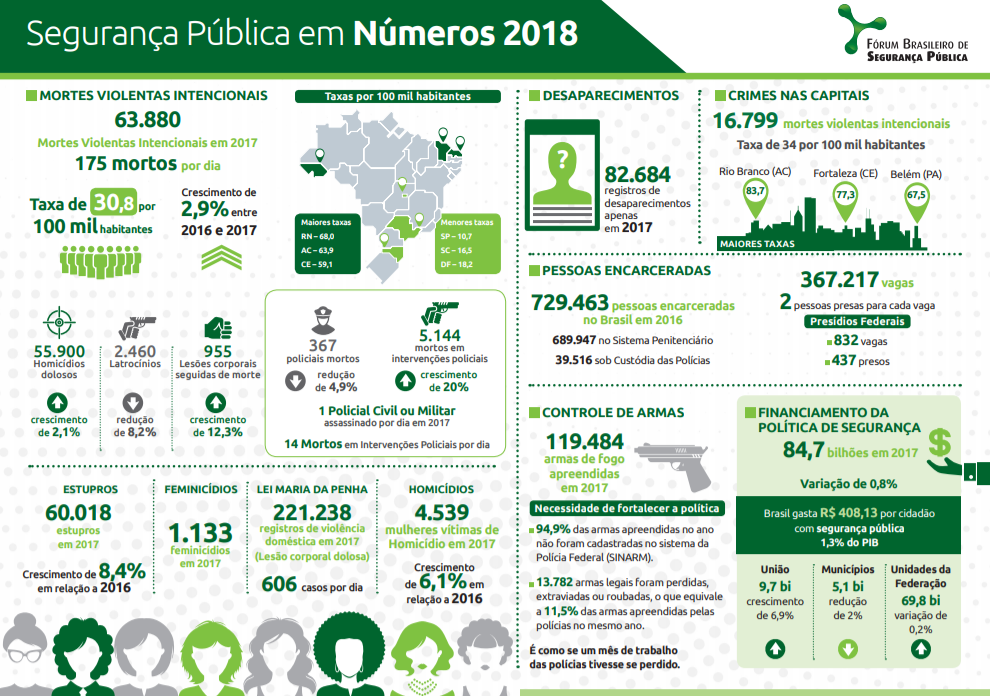Seven violent deaths every hour recorded in 2017, in Brazil
In total, 63,880 people died as a result of murder, murder during a robbery and bodily harm leading to death. This number is 2.9% higher than in the previous year.
 TAPANÃ - PARÁ 30 04 2018 On Monday 30, the Military Police in the state initiated operation Sáfara 3, to combat criminality in greater Belém. Two areas with a high crime rate, Guamá e Tapanã, were prioritised on the first day of the operation. Police went from the neighbourhood of Guamá into Terra Firme and Jurunas. The areas of Pratinha, Bengui and Parque Verde were approached from Tapanã. The choice of location was based on criminal incidents monitored by Military Police intelligence. In the neighbourhoods of Bengui and Cabanagem alone eleven murders were reported in the month of April. PHOTO: THIAG GOMES / AG. PARÁ
TAPANÃ - PARÁ 30 04 2018 On Monday 30, the Military Police in the state initiated operation Sáfara 3, to combat criminality in greater Belém. Two areas with a high crime rate, Guamá e Tapanã, were prioritised on the first day of the operation. Police went from the neighbourhood of Guamá into Terra Firme and Jurunas. The areas of Pratinha, Bengui and Parque Verde were approached from Tapanã. The choice of location was based on criminal incidents monitored by Military Police intelligence. In the neighbourhoods of Bengui and Cabanagem alone eleven murders were reported in the month of April. PHOTO: THIAG GOMES / AG. PARÁ
In 2017, seven people suffered violent deaths every hour in Brazil. This alarming data is part of the Brazilian Annual Report on Public Security, published this Thursday 8 August, by the Brazilian Forum for Public Security.
According to the report, there was a 20% increase in deaths due to police interventions: 5,144 people, the equivalent of 14 per day, died under these circumstances, almost a thousand more than recorded in 2017. Civil and military police are included in the statistics – one police officer per day was murdered in the last year.
“These figures show that the public security policy that has been in place for the past 20 years is fundamentally flawed. We need to reform our model, starting with the police who should be demilitarised and should be subject to external control. We also need to break with the logic that arresting people leads to an increase in safety. We currently have the third largest prison population in the world and records of violent deaths are increasing every year.” Said Rafael Custódio, Coordinator of Institutional Violence at Conectas.
The method used by the Brazilian Form for Public Security in arriving at these figures, was to count cases of intentional violent death, which includes cases of felony murder, murder committed during a robbery, bodily harm leading to death, police deaths in confrontation and deaths resulting from police intervention. “It should be stressed that in the case of records on rape and domestic violence there is endemic under-notification. In other words, these figures are actually much higher as the victims, mostly women are afraid to denounce aggressors.” Rafael added.
The Yearbook also provides data about the 119 thousand weapons confiscated and investment in public security. In 2017, the government invested 1.3% of GDP and proportionately spent around R$34 per month per citizen. Another study, however shows that violent deaths cost the public coffers around 4.3% of GDP and that the death of a young person costs as much as R$ 550 thousand, taking into account the loss of productivity over a lifetime.
See a summary of the data:



